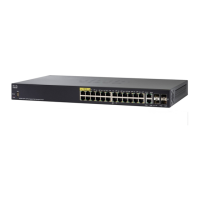Introduction
43 Cisco Sx350 Ph. 2.2.5 Devices - Command Line Interface Reference Guide
1
To use these special characters as single-character patterns, remove the special
meaning by preceding each character with a backslash (\).
The following examples are single-character patterns matching a dollar sign, an
underscore, and a plus sign, respectively.
\$ \_ \+
You can specify a range of single-character patterns to match against command
output. For example, you can create a regular expression that matches a string
containing one of the following letters: a, e, i, o, or u. Only one of these characters
must exist in the string for pattern matching to succeed. To specify a range of
single-character patterns, enclose the single-character patterns in square
brackets ([ ]). For example, [aeiou] matches any one of the five vowels of the
lowercase alphabet, while [abcdABCD] matches any one of the first four letters of
the lower- or uppercase alphabet.
You can simplify ranges by entering only the endpoints of the range separated by
a dash (-). Simplify the previous range as follows:
[a-dA-D]
To add a dash as a single-character pattern in your range, include another dash
and precede it with a backslash:
[a-dA-D\-]
You can also include a right square bracket (]) as a single-character pattern in your
range, as shown here:
[a-dA-D\-\]]
The previous example matches any one of the first four letters of the lower- or
uppercase alphabet, a dash, or a right square bracket.
You can reverse the matching of the range by including a caret (^) at the start of
the range. The following example matches any letter except the ones listed:
[^a-dqsv]
The following example matches anything except a right square bracket (]) or the
letter d:
[^\]d]

